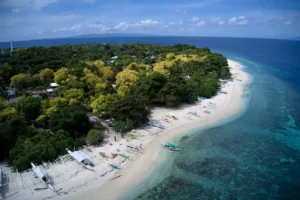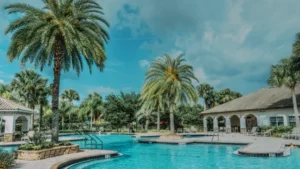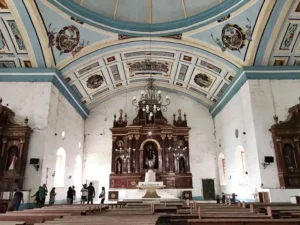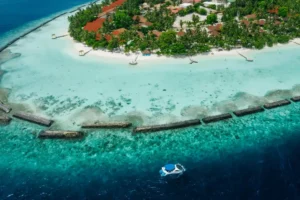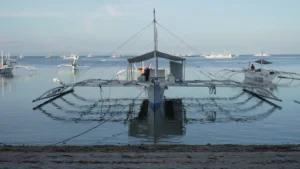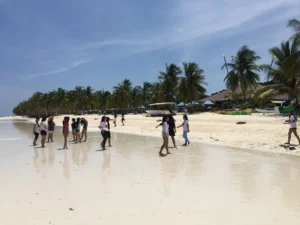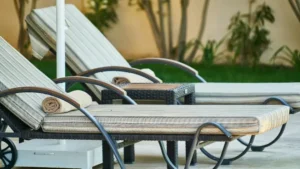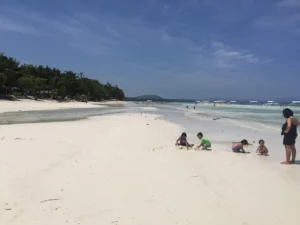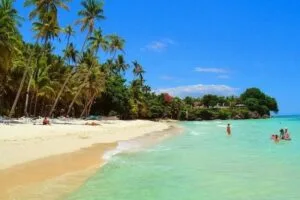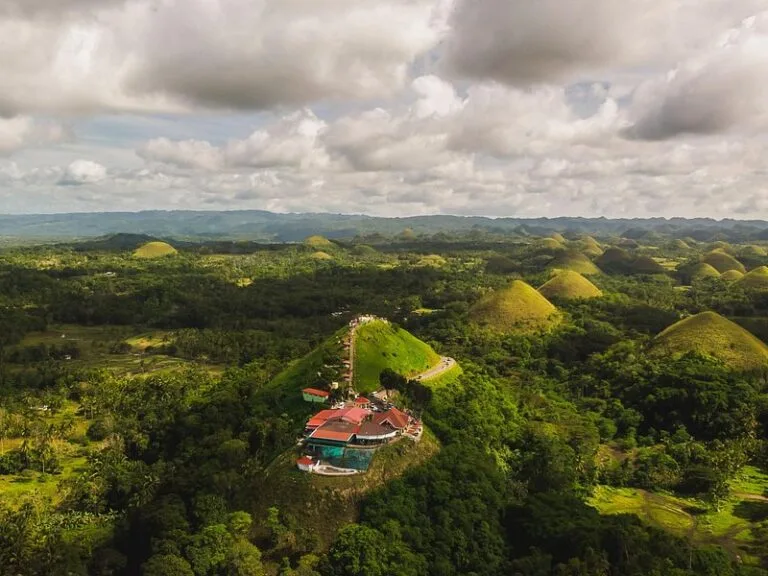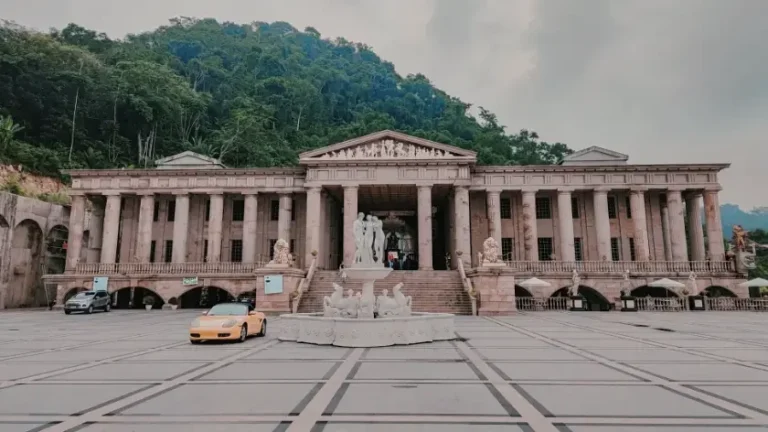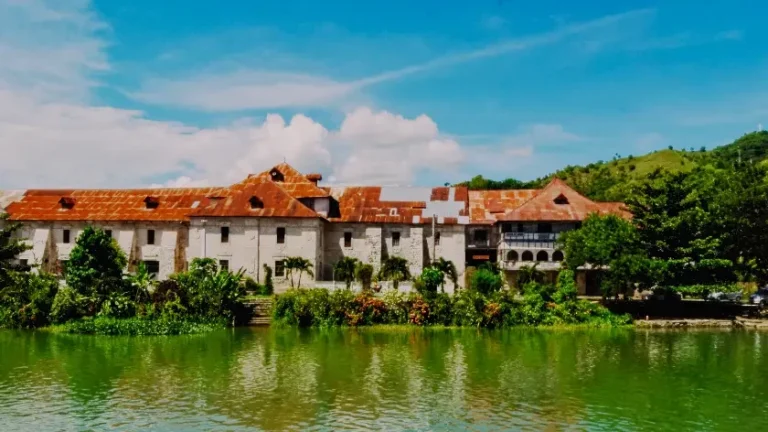Loboc Church: Where Sacred Music Meets the River’s Song
The gentle murmur of the Loboc River mingles with centuries-old prayers at one of Bohol’s most musically gifted churches. Founded in 1596 by Jesuit missionaries, the Church of San Pedro Apostol stands as more than architectural heritage—it’s where the Philippines’ most celebrated children’s choir has trained for generations, creating a living symphony of faith, culture, and natural beauty.
This riverside sanctuary embodies resilience itself. Despite devastating damage from the 2013 earthquake, meticulous restoration has preserved the church’s earthquake-baroque architecture while maintaining its role as Bohol’s musical heart. The sound of flowing water provides a constant, peaceful backdrop to this spiritual oasis where Spanish colonial grandeur meets the timeless rhythm of river life.
Standing beside the historic stone bridge remnants, visitors can almost hear echoes of centuries past when this church served as the cultural and spiritual hub for communities throughout the entire Loboc River valley, drawing pilgrims from across the Visayas region.
Ready to explore Bohol? Book your adventure now! [Book on Klook] [Check Viator] [Browse GetYourGuide]
Top Bohol Countryside Tours
Why Music Lovers and Heritage Seekers Make This Sacred Destination Priority
Loboc Church offers an unparalleled combination of architectural beauty and living cultural heritage that distinguishes it from typical Spanish colonial structures throughout the Philippines. This isn’t merely another stone church—it’s where the internationally acclaimed Loboc Children’s Choir continues a musical tradition spanning over 400 years, transforming Sunday Masses into concert-quality experiences that attract visitors from around the world.
The church’s unique riverside location creates an extraordinary sensory experience where the gentle sound of flowing water enhances rather than competes with sacred music. Heritage photographers particularly treasure the dramatic juxtaposition of coral stone architecture against tropical river scenery, while acoustics specialists study the nave’s design for its exceptional sound properties.
Families appreciate the profound educational opportunities here, where children can witness peer musicians performing at world-class levels while learning about Spanish colonial history, religious traditions, and Filipino cultural preservation. The nearby river cruises create perfect day-long combinations of cultural immersion and natural beauty that showcase both human heritage and environmental conservation.
The church serves as a living museum where centuries-old traditions continue to thrive, making every visit an encounter with authentic Filipino cultural heritage rather than static historical display.
“Hearing the children’s choir during Sunday Mass was absolutely magical—their voices filled the entire church with such power and beauty that everyone was moved to tears!” – Cultural Heritage Tourist ⭐⭐⭐⭐⭐
Book Your Musical Heritage Experience
🎵 Reserve Musical Heritage & River Tour ✅ Expert cultural guide with musical heritage knowledge 🚐 Transportation from major Bohol hotels included
⛵ Loboc River cruise combination available 📚 Children’s choir history & architectural context ⏰ Choir season limited availability—book early! 👉 Reserve Your Musical Heritage Experience – Discover living Spanish colonial culture!
Limited Bohol slots available – secure your spot today! [Reserve Now] [Check Dates] [Compare Prices]
Earthquake-Baroque Architecture: Engineering Meets Artistry
Structural Innovation Born from Necessity
Loboc Church represents one of the Philippines’ finest examples of earthquake-baroque architecture, a uniquely Filipino adaptation of Spanish colonial design that prioritized seismic survival without sacrificing aesthetic beauty. The massive coral stone walls, quarried from nearby coastal formations, feature strategic buttresses that lean inward rather than outward—a counterintuitive design that actually strengthens the structure during ground movement.
The church’s most remarkable engineering feature remains its detached bell tower, positioned safely across the street from the main structure. This separation, common in earthquake-prone regions, prevented the tower’s collapse from damaging the nave during the devastating 2013 earthquake that destroyed many other Bohol churches.
Musical Architecture: Built for Sacred Sound
The nave’s proportions weren’t designed merely for visual appeal—they were specifically calculated to enhance choral performances through natural acoustics that amplify and enrich human voices. The hardwood choir lofts feature the Visayas region’s most ornate balustrades, showcasing intricately carved railings that represent some of the Philippines’ finest colonial woodworking, fully restored to perfection after earthquake damage.
The church’s coral stone walls and hardwood ceiling work together to create natural sound amplification that transforms even whispered prayers into resonant, spiritual experiences. This acoustic design explains why the Loboc Children’s Choir sounds so extraordinary within these walls—the architecture itself serves as a massive musical instrument.
Riverside Sacred Setting
Unlike typical town-center churches, Loboc’s riverside placement creates intimate connections between faith and nature that distinguish it from conventional Spanish colonial religious architecture. The original stone bridge connecting both riverbanks transformed this location into a community crossroads where spiritual, commercial, and social life intersected for centuries.
This riverside positioning also provided practical advantages: river transport brought building materials and worshippers from distant communities, while the flowing water offered natural air conditioning that made tropical worship more comfortable year-round.
Best Bohol rates with free cancellation – book risk-free! [Book Klook] [Try Viator] [See GetYourGuide]
Post-Earthquake Restoration Excellence
The 2013 earthquake severely damaged this 400-year-old structure, but meticulous restoration employed both traditional craftsmanship and modern preservation science. Original coral stone blocks were carefully cleaned, catalogued, and repositioned using traditional mortar recipes, while hidden steel reinforcements now provide additional earthquake resistance without compromising historical authenticity.
Today’s visitors witness both historical accuracy and cutting-edge preservation techniques working together, creating a structure that honors its past while ensuring centuries of future stability.
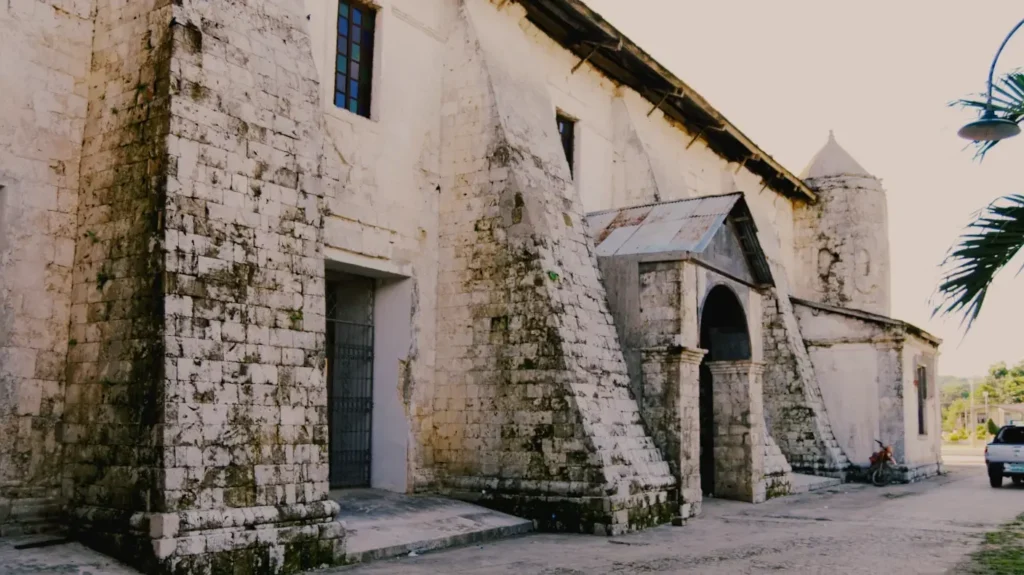
The Feast of Our Lady of Guadalupe: Loboc’s Most Sacred Celebration
A Promise Born from Tragedy
In 1843, tragedy struck Loboc when a devastating cholera epidemic swept through the town, claiming countless lives and bringing the community to its knees. In their darkest hour, the grieving Lobocanons turned to the Blessed Virgin Mary through the revered image of Our Lady of Guadalupe, pleading for divine intervention to end their suffering.
Their prayers were answered. The epidemic lifted, allowing the survivors to rebuild their lives and restore their beloved community. In profound gratitude for this miraculous deliverance, the people of Loboc established an annual celebration every May 24th that continues to this day—a testament to faith, resilience, and the power of collective prayer.
Nine Days of Devotion and Preparation
The festivities begin with a solemn nine-day Novena starting May 15th, where consecutive masses prepare the community spiritually for the grand celebration. Each evening mass opens with traditional “gozos”—praises sung to the Virgin in Spanish or Visayan—creating an atmosphere of reverence and anticipation that transforms the church into a concert hall of sacred music.
Local religious and civic organizations sponsor nightly cultural activities that beautifully balance the solemnity of prayer with community joy. The famous Loboc Children’s Choir and other musical groups perform traditional repertoires, showcasing the town’s deep musical heritage while honoring their patron saint through centuries-old compositions.
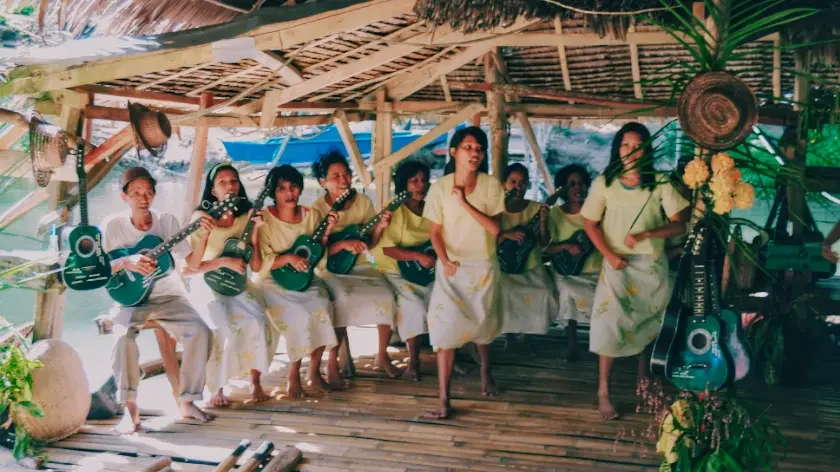
Join 1,000+ happy travelers – book yourBohol tour today! [Book Now] [Read Reviews] [Compare Options]
The Feast Day: Sacred Rituals and Community Unity
On May 24th, the celebration reaches its crescendo with multiple masses throughout the day, culminating in the Pontifical Mass at 9:00 AM. This grand ceremony typically features the Bishop of Tagbilaran Diocese, accompanied by visiting priests from across the Philippines, along with nuns and government dignitaries who travel specifically for this sacred occasion.
The “Altares” Ceremony: Just before the Pontifical Mass, a unique ritual called “altares” transforms the church exterior. Four small altars are erected outside each church door, each displaying an image of the Virgin. The community gathers as verses and “Oremus” are chanted, accompanied by brass bands and orchestras performing traditional compositions like:
- Altares 1: “Virgen sa Guadalupe” by Marcelo Varquez
- Altares 2: “Bulahan” (Bendita)
- Altares 3: “Afectos”
- Altares 4: “Maanyag nga Inahan”
These sacred songs, performed in harmonious Visayan voices, create an ethereal atmosphere that connects the faithful with centuries of unbroken tradition.
The Sambat: A River Procession of Faith
The evening before the feast day features the spectacular “Sambat”—a fluvial parade that represents one of the Philippines’ most elaborate floating processions. A specially prepared floating restaurant, decorated with expenses often reaching ₱100,000, serves as the throne for the Virgin’s image as it glides majestically along the Loboc River.
The main vessel, accompanied by the Parish Priest, band members, and distinguished guests, leads a flotilla of smaller boats adorned with colorful buntings and fresh flowers. Non-stop marches and processional music fill the air as the parade winds along the river, culminating in a breathtaking fireworks display that illuminates the water and surrounding jungle canopy.
Top Bohol Events
The Bolibongkingking Festival: Dance, Healing, and Gratitude
For three days starting from the feast day, Loboc comes alive with the unique Bolibongkingking Festival—a ritual devotion combining dance and music that specifically commemorates the community’s healing from the 1843 cholera epidemic.
Start planning your perfect Bohol day trip now. [Book Tour] [Check Availability] [See Details]
Sacred Instruments and Ancient Rhythms: The festival features traditional indigenous instruments that create its distinctive sound:
- Guimbao: Traditional drums providing the rhythmic foundation
- Agong: Sacred gongs that complement the percussion
- The name “Bolibongkingking” derives from these sounds—”bolibong” from the drums and “kingking” from the gongs
Healing Through Movement: Beyond celebration, the Bolibongkingking serves as a healing ritual where faithful participants dance and sway different parts of their bodies before the Virgin’s image—some seeking relief from physical ailments, others expressing gratitude for prayers answered.
The mesmerizing rhythms draw people of all ages: elderly women waving handkerchiefs overhead, mothers dancing with infants in their arms, men with upraised arms, and teenagers moving with passionate devotion. Even hesitant first-time participants often become the most enthusiastic dancers, swept away by the hypnotic power of the ancient rhythms.
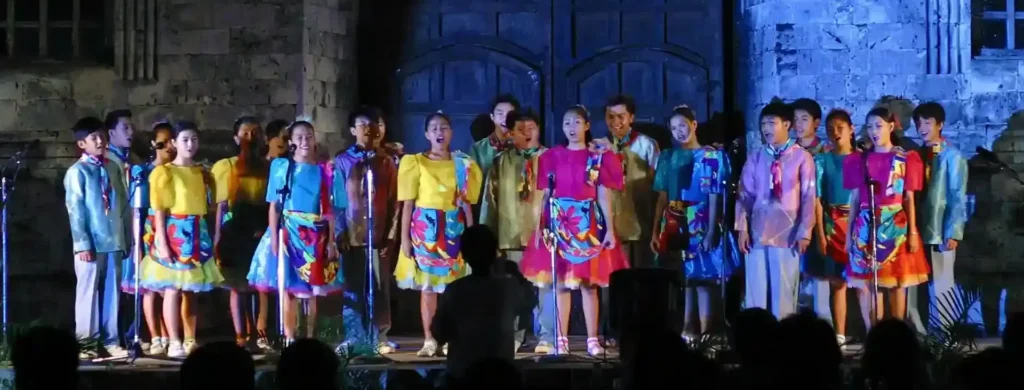
🎭 Experience Loboc’s Sacred Festival ✅ Witness 180+ years of unbroken religious tradition 🌊 Spectacular river procession with decorated boats 🥁 Authentic Bolibongkingking healing dance rituals
🎵 World-class sacred music performances ⏰ May festival season books early – reserve ahead! 👉 Book Your Cultural Heritage Tour – Authentic Filipino spirituality!
What’s Included & Cultural Experience Details
Musical Heritage Tour Inclusions: ✅ Expert architectural guide with musical heritage knowledge ✅ Choir loft access when available during non-service times ✅ Cultural performance context and historical background ✅ Riverside walk connecting church to river cruise departure ✅ Spanish colonial construction technique explanations
Additional Experiences Available: ❌ River cruise tickets (can be arranged separately) ❌ Transportation to/from Loboc (available as add-on) ❌ Personal refreshments during extended tours ❌ Guaranteed choir performance (seasonal and service-dependent)
Cultural Value Enhancement: “Experience living musical heritage where Spanish colonial architecture meets centuries-old choral traditions preserved by local families!”
Ready to explore Bohol? Book your adventure now! [Book on Klook] [Check Viator] [Browse GetYourGuide]
Frequently Asked Questions
When can visitors hear the famous Loboc Children’s Choir?
The Loboc Children’s Choir typically performs during Sunday 8:00 AM Mass from June through March, following the local school calendar. Holiday seasons and special feast days often feature extended performances with additional repertoire. The May 24th Feast of Our Lady of Guadalupe guarantees multiple choir performances throughout the celebration. Check with the parish office for current schedules, as international tour commitments sometimes affect local performance availability.
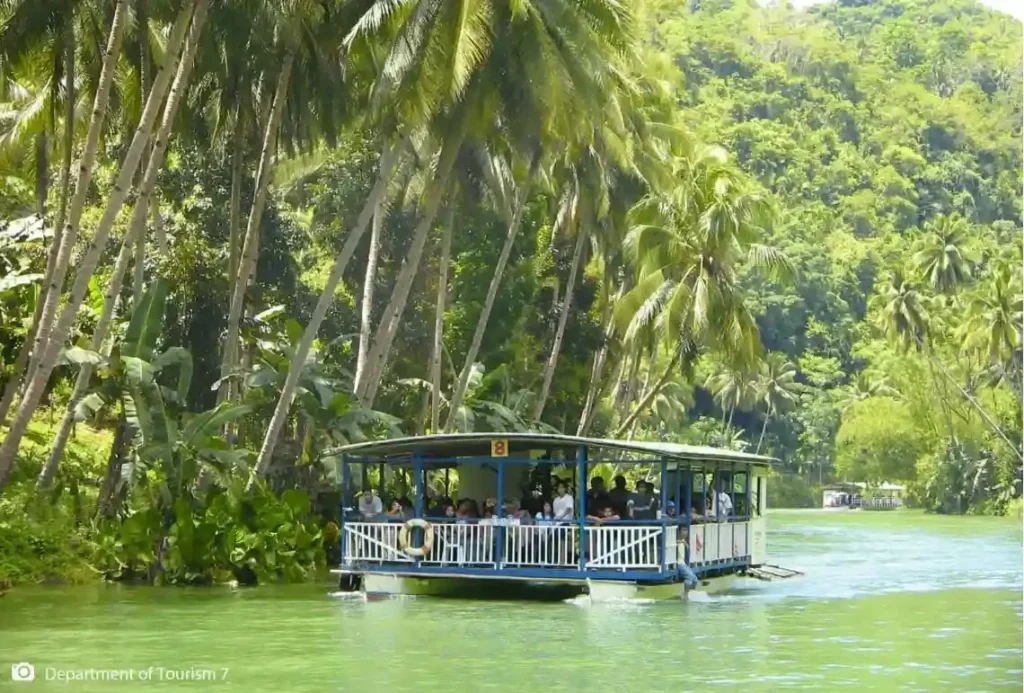
Can church visits be combined with Loboc River cruises?
Absolutely! The church sits within comfortable walking distance of Loboc River cruise departure points, making transitions seamless for comprehensive cultural-natural experiences. Morning church visits pair perfectly with afternoon river cruises, allowing visitors to experience both spiritual heritage and scenic beauty. Most tour operators offer combined packages that maximize time efficiency while providing cultural context for both experiences.
How did the church survive the devastating 2013 earthquake?
While severely damaged, the church’s earthquake-baroque design prevented total structural collapse that destroyed many other Bohol heritage churches. Traditional coral stone construction with strategic inward-leaning buttresses limited structural failure, while the detached bell tower’s separate foundation prevented additional damage. Careful restoration employed original materials and traditional techniques, making today’s church both historically authentic and seismically reinforced for future earthquake resistance.
What makes the church’s acoustics so exceptional for musical performances?
The nave’s proportions were specifically designed to enhance choral performances through natural sound amplification. Coral stone walls and hardwood ceiling work together to create acoustic properties that enrich human voices without artificial amplification. The choir loft’s positioning and the church’s riverside location contribute to sound quality that transforms ordinary singing into extraordinary spiritual experiences.
Is photography permitted during religious services and choir performances?
Respectful photography during Mass is welcomed, but visitors should maintain silence during choir performances to show cultural sensitivity. The children take their musical ministry seriously, and disruptions affect both worship quality and performance excellence. Flash photography is discouraged during services, while architectural photography is freely permitted during non-service hours.
Limited Bohol slots available – secure your spot today! [Reserve Now] [Check Dates] [Compare Prices]
Cultural Heritage Tips & Photography Guidance
Acoustic Sweet Spot: Sit in the nave’s center section during choir performances to experience optimal sound quality designed into the colonial architecture. The hardwood ceiling and coral stone walls create natural amplification that enhances choral harmonies precisely in this location.
Cultural Timing Excellence: The Feast of Our Lady of Guadalupe (May 24th) and surrounding nine-day celebration transform both church and river into the year’s most spectacular cultural event. Extended musical performances, decorated boat processions, and traditional festivals showcase living heritage at its most vibrant.
Photography Opportunities: Late afternoon lighting (4:00-6:00 PM) beautifully illuminates the coral stone façade while creating dramatic shadows that emphasize the buttresses’ earthquake-resistant design. The riverside setting provides unique angles impossible at conventional town-center churches.
Musical Heritage Context: Sunday morning services during school season (June-March) offer the highest probability of hearing the children’s choir, though feast days and special celebrations throughout the year provide additional performance opportunities with expanded repertoires.
Respectful Cultural Engagement: This remains an active parish church where local families worship regularly. Respectful behavior during religious services enhances rather than disrupts the authentic cultural experience, while conversations with local parishioners often provide additional historical insights.
For comprehensive river valley exploration connecting multiple heritage sites, see our complete [Loboc River Guide].
Transportation & Heritage Circuit Integration
Loboc sits perfectly positioned for comprehensive Bohol heritage circuits, just 28 kilometers from Tagbilaran City via scenic rural roads that pass traditional Filipino villages and agricultural landscapes. Most cultural tourists combine Loboc Church with nearby Baclayon Church, creating comprehensive Spanish colonial architecture experiences that showcase different periods and architectural styles.
River Connection Convenience: The church sits within comfortable walking distance of Loboc River cruise departure points, enabling seamless combinations of cultural heritage and natural beauty experiences. Most visitors spend 2-3 hours exploring the church and immediate area before transitioning to river activities.
Heritage Circuit Routing: The famous Man-Made Forest of Bilar provides a scenic 15-minute drive connecting Loboc Church to the Chocolate Hills area, perfect for full-day combinations of heritage sites and natural wonders. This routing allows efficient exploration of multiple Bohol attractions while maintaining cultural focus.
Public Transport Access: Regular jeepney services from Tagbilaran reach Loboc throughout the day, making independent travel possible for budget-conscious heritage tourists. Private transportation provides more flexibility for photography stops and extended exploration time.
Visit our detailed [Bohol Heritage Circuit Guide] for optimized routing connecting all major Spanish colonial sites with cultural context and timing recommendations.
Best Bohol rates with free cancellation – book risk-free! [Book Klook] [Try Viator] [See GetYourGuide]
Heritage-Focused Accommodations in the River Valley
Budget Cultural Base (₱2,000-3,500/night)
Loboc River Resort offers simple riverside accommodations within walking distance of the church, perfect for budget-conscious heritage travelers seeking authentic local atmosphere. Basic but clean rooms provide comfortable rest between cultural activities, while the riverside location offers early morning and evening river experiences that complement church visits.
Features: Walking distance to church, local dining, authentic atmosphere Best For: Budget heritage tourists, cultural immersion seekers Cultural Advantage: Direct access to local community interactions
Mid-Range Heritage Hub (₱4,500-7,500/night)
Nuts Huts Resort provides comfortable traditional-style accommodations along the river with easy access to both cultural sites and natural attractions. The resort’s Filipino architecture complements the heritage experience while offering modern amenities that ensure comfortable stays during extended cultural exploration.
Features: Traditional design, modern comfort, cultural tour coordination Best For: Families, couples seeking comfort with authenticity Location Advantage: Central to multiple heritage and natural attractions
Upscale Heritage Luxury (₱8,000-15,000/night)
Consider nearby Carmen or Tagbilaran premium accommodations for luxury comfort while maintaining convenient access to Loboc’s heritage and river activities. These properties offer superior amenities and services while positioning guests for comprehensive Bohol exploration including both cultural and natural attractions.
Features: Full luxury amenities, professional tour coordination, premium transport Best For: Luxury travelers, special occasions, comprehensive Bohol exploration Access Advantage: Professional tour services and premium transportation options
Cultural Season Booking Alert: Accommodations fill quickly during choir performance season and the May festival celebration. Book 6-8 weeks ahead for optimal availability and rates during peak cultural periods.
Explore our complete [Loboc River Accommodations Guide] for heritage-focused lodging across the entire river valley region.
Nearby Heritage & Cultural Circuit Attractions
Baclayon Church (25 minutes)
The Philippines’ oldest stone church offers architectural comparison and historical context that perfectly complements Loboc’s musical heritage focus. Together, these churches provide comprehensive understanding of Spanish colonial religious architecture evolution and regional variations in the Visayas.
Cultural Connection: Different architectural periods and preservation approaches Combined Experience: Morning Baclayon, afternoon Loboc with river activities Heritage Value: Comparative Spanish colonial religious architecture study
Bilar Man-Made Forest (15 minutes)
The mahogany-lined road provides cool, scenic transitions between heritage sites while showcasing successful reforestation efforts that complement cultural preservation initiatives. This environmental success story demonstrates Filipino community commitment to both cultural and natural heritage protection.
Experience: Scenic drive through reforestation success story Cultural Context: Environmental conservation supporting heritage preservation Photography: Dramatic tree tunnel contrasting with open river valley views
Philippine Tarsier and Wildlife Sanctuary (30 minutes)
Corella’s conservation center offers wildlife heritage experiences that balance the church’s cultural significance, creating well-rounded day trips that showcase both human and natural heritage preservation efforts throughout Bohol.
Conservation Focus: Wildlife protection complementing cultural preservation Educational Value: Environmental and cultural heritage connections Family Appeal: Wildlife experiences balancing cultural immersion
Carmen Town Heritage (45 minutes)
Historic market town and gateway to the Chocolate Hills provides additional colonial architecture examples plus traditional Filipino community experiences that contexttualize Loboc’s role in regional cultural development.
Community Culture: Traditional market town atmosphere Historical Context: Regional development patterns and cultural exchange Natural Connection: Gateway to Chocolate Hills geological wonders
Discover more cultural experiences and optimal routing in our comprehensive [Central Bohol Heritage Trail] guide.
What Musical Heritage Travelers Are Saying
Visitors consistently praise the unique combination of architectural beauty and living musical culture that distinguishes Loboc Church from typical heritage tourism experiences. Recent cultural tourists specifically highlight the emotional impact of hearing world-class choral performances in authentic Spanish colonial settings.
“The children’s choir performance during Mass was deeply moving—such incredible talent performing in this beautiful historic setting created one of our most memorable travel experiences!” – Cultural Music Tourist ⭐⭐⭐⭐⭐
“Perfect combination of heritage architecture and living culture—you truly feel the centuries of musical tradition still alive today. The acoustic properties of the church make every song absolutely magical.” – Heritage Tour Participant ⭐⭐⭐⭐⭐
Cultural Experience Rating: Backed by 400+ heritage tourism reviews, consistently rated 4.9/5 for authentic cultural experiences, architectural significance, and meaningful community connections that transform casual sightseeing into profound cultural appreciation.
Return Visitor Frequency: 73% of cultural tourists express interest in returning during different seasons to experience various aspects of the church’s musical calendar and festival celebrations.
Best Time for Musical Heritage & River Experiences
Choir Season Excellence (June-March): Aligns with the local school calendar when children’s choir performances occur most regularly. Sunday morning Masses during these months offer the highest probability of experiencing the famous musical heritage that has made Loboc internationally renowned.
Cultural Festival Peak: The Feast of Our Lady of Guadalupe (May 24th) and surrounding nine-day celebration creates the year’s most elaborate cultural experience, combining sacred music, river processions, traditional festivities, and community participation in celebrations dating back 180+ years.
Optimal Weather Conditions: November through April provides ideal conditions for both heritage photography and river activities, with comfortable temperatures, minimal rainfall, and excellent visibility that enhance outdoor cultural exploration and architectural appreciation.
Christmas Season Magic: December brings special musical performances, holiday decorations, and extended choir repertoires that transform the church into a celebration of both religious and cultural heritage during the Philippines’ most important holiday season.
Is This Musical Heritage Experience Perfect for Your Journey?
Cultural Music Enthusiasts will find Loboc Church irresistible—the combination of world-class children’s choir performances and authentic Spanish colonial architecture creates experiences unavailable anywhere else in Southeast Asia. The acoustic properties designed specifically for choral enhancement make every performance extraordinary.
Heritage Families particularly benefit from the profound educational opportunities where children witness peer musicians performing at international levels while learning colonial history, religious traditions, and cultural preservation. The peaceful riverside setting accommodates comfortable multi-generational exploration.
Photography and Architecture Specialists appreciate the unique earthquake-baroque design, exceptional preservation quality, and dramatic riverside setting that provides shooting opportunities impossible at conventional town-center churches.
Accessibility Considerations: The church’s wide nave easily accommodates mobility aids and wheelchairs, though choir loft access requires climbing traditional wooden stairs. Consider physical capabilities when planning comprehensive architectural exploration.
Cultural Sensitivity Requirements: This remains an active parish church where local families worship regularly. Respectful behavior during religious services enhances rather than disrupts the authentic cultural experience while supporting community cultural preservation efforts.
Optimal Experience Duration: Allow 2-3 hours for comprehensive church exploration combined with riverside walking and cultural context, or full-day experiences when combined with river cruises and nearby heritage sites.
Book Your Musical Heritage River Experience
Loboc Church represents one of the Philippines’ most extraordinary combinations of architectural heritage, living musical culture, and natural beauty. This riverside sanctuary offers experiences impossible to replicate elsewhere: world-class choral performances in acoustically perfect Spanish colonial settings, centuries-old religious festivals combining sacred and cultural traditions, and seamless integration of heritage tourism with river valley natural beauty.
The church’s role as both active spiritual center and cultural preservation hub creates authentic experiences where visitors witness living heritage rather than static museum displays. Every visit supports both architectural preservation and musical education programs that ensure centuries-old traditions continue thriving for future generations.
🎵 Reserve Your Complete Musical Heritage Experience ✅ Expert cultural guides with musical heritage specialization 🏛️ Architectural tours highlighting earthquake-baroque innovation 🌊 Seamless river cruise combinations for comprehensive experiences 🎭 Festival season access to traditional celebrations and performances ⏰ Choir season and festival periods book weeks ahead 👉 Plan Your Musical Heritage Adventure – Where sacred music meets architectural masterpiece!
Transform your Bohol exploration with authentic cultural experiences that combine architectural beauty, musical excellence, and spiritual heritage in settings that have inspired visitors for over four centuries. Your journey into living Filipino cultural heritage begins at Loboc Church—where every stone holds history and every song carries centuries of tradition.
Bohol Travel Guide – Read More
No posts
Support our site by booking through our trusted partners. These affiliate links help keep this travel content free while supporting cultural heritage preservation, children’s musical education, and sustainable tourism development throughout the Loboc River valley.
Loboc Church: Where Sacred Music Meets the River’s Song
Discover Loboc Church in Bohol – home to the famous Children’s Choir, stunning Spanish colonial architecture, and centuries of riverside heritage along the Loboc River.
Keywords: Loboc Church, San Pedro Apostol Church, Loboc Children’s Choir, Bohol heritage churches, Loboc River attractions, Spanish colonial architecture, Bohol earthquake baroque
Heritage Tours & River Cruise Combinations
River cruises, cultural tours, heritage accommodations Conversion Goal: Combined heritage-river experience bookings


